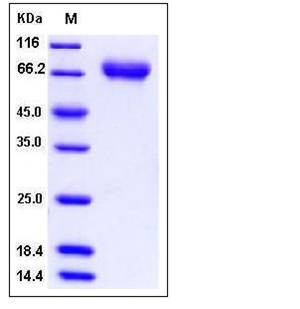Human FLRT2 Protein (His Tag)
KIAA0405,UNQ232/PRO265
- 100ug (NPP3869) Please inquiry
| Catalog Number | P11296-H08H |
|---|---|
| Organism Species | Human |
| Host | Human Cells |
| Synonyms | KIAA0405,UNQ232/PRO265 |
| Molecular Weight | The secreted recombinant human FLRT2 comprises 515 amino acids and has a calculated molecular mass of 57.7 kDa. The apparent molecular mass of the recombinant protein is approximately 75 kDa in SDS-PAGE under reducing conditions due to glycosylation. |
| predicted N | Cys 36 |
| SDS-PAGE |  |
| Purity | > 98 % as determined by SDS-PAGE |
| Protein Construction | A DNA sequence encoding the human FLRT2 (O43155) extracellular domain (Met 1-Ser 539) was expressed, with a C-terminal polyhistidine tag. |
| Bio-activity | Measured by the ability of the immobilized protein to support the adhesion of Neuro‑2A mouse neuroblastoma cells. When cells are added to coated plates(5μg/mL, 100μL/well), approximately 50%-70% will adhere after 1 hour at 37℃. |
| Research Area | Cancer |Signal transduction |Cytoskeleton / ECM |Cell Adhesion |Cell Adhesion Molecules |Endothelial | |
| Formulation | Lyophilized from sterile PBS, pH 7.4 1. Normally 5 % - 8 % trehalose and mannitol are added as protectants before lyophilization. Specific concentrations are included in the hardcopy of COA. |
| Background | Fibronectin Leucine-Rich Transmembrane (FLRT) proteins are glycosylated membrane proteins expressed at the cell surface which localise in a homophilic manner to cell-cell contacts expressing the focal adhesion marker vinculin. FLRT1, FLRT2, and FLRT3, the three genes encode putative type I transmembrane proteins, each containing 10 leucine-rich repeats (LRR), a type III fibronectin (FN) domain, followed by the transmembrane region, and a short cytoplasmic tail. FLRT family members may function in cell adhesion and/or receptor signalling. Each member of the FLRT family has a distinct, highly regulated expression pattern, as was seen for the NLRR family. FLRT2 is expressed in a subset of the sclerotome, adjacent to the region that forms the syndetome, suggesting that interaction with FGF signalling may be a general property of FLRT proteins. All FLRTs can interact with FGFR1 and FLRTs can be induced by the activation of FGF signalling by FGF-2. FLRT proteins have a dual role, promoting FGF signalling and modulating homotypic cell adhesion. FLRT2 played critical roles in craniofacial development, and it was also present in the vomero-nasal organ, mandibular primodia, and the posterior aspects of the unfused and fused secondary palatal shelves. |
| Reference |
